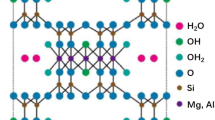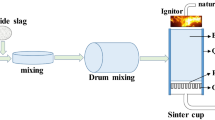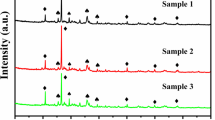Abstract
Cobalt leaching resistance of the solidified radioactive sludge subject to disposal was evaluated. The sludge powders ((Fe2O3), NiO, and Cr2O3) with non-radioactive cobalt powder was homogeneously mixed with ferro frit and treated in hot isostatic pressing process. Although the mixing ratio of the ferro frit in total solidified sludge waste was less than 25% and heating temperature in HIP process was lower than 1000 °C, the cobalt leachability indices in all the solidified sludge were ranged from 13.9 to 18.4. The study showed the solidified sludge waste satisfied the leachability index criteria for waste disposal, which was six.


















Similar content being viewed by others
References
Lee BS, Kim KJ (2003) Design experience of liquid radioactive waste system of nuclear power plants in Korea. Proc. Korean Radioact Waste Soc 1(2):43–47
Cui Y, Liu S, Smith K, Yu K, Hu H, Jiang W, Li Y (2016) Characterization of corrosion scale formed on stainless steel delivery pipe for reclaimed water treatment. Water Res 88:816–825
Awang H, Ahmad MH, Al-Mulali MZ (2015) Influence of kenaf and polypropylene fibres on mechanical and durability properties of fibre reinforced lightweight foamed concrete. J Eng Sci Technol 10(4):496–508
National Center for Biotechnology Information (2022) PubChem Compound Summary for CID 14833, Hematite. Retrieved May 31, 2022 from https://pubchem.ncbi.nlm.nih.gov/compound/Hematite.
National Center for Biotechnology Information (2022) PubChem Compound Summary for CID 14805, Nickel oxide. Retrieved May 31, 2022 from https://pubchem.ncbi.nlm.nih.gov/compound/Nickel-oxide.
National Center for Biotechnology Information (2022) PubChem Compound Summary for CID 517277, Chromium(III) oxide. Retrieved May 31, 2022 from https://pubchem.ncbi.nlm.nih.gov/compound/Chromium_III_-oxide.
Jeong GH, Jung KJ, Baik ST, Chung US, Lee KW, Park SK et al (2002) Solidification of slurry waste with ordinary Portland cement (No. KAERI/RR--2302/2002). Korea Atomic Energy Research Institute
Raj K, Prasad KK, Bansal NK (2006) Radioactive waste management practices in India. Nucl Eng Des 236(7–8):914–930
Caillahua MC, Moura FJ (2018) Technical feasibility for use of FGD gypsum as an additive setting time retarder for Portland cement. J Market Res 7(2):190–197
Su JF, Schlangen E, Qiu J (2013) Design and construction of microcapsules containing rejuvenator for asphalt. Powder Technol 235:563–571
Singh BK, Hafeez MA, Kim H, Hong S, Kang J, Um W (2021) Inorganic waste forms for efficient immobilization of radionuclides. ACS ES&T Eng 1(8):1149–1170
Marra JC, Kim DS (2014) Towards increased waste loading in high level waste glasses: developing a better understanding of crystallization behavior. Procedia Mater Sci 7:87–92
Duan Z, Arjmand F, Zhang L, Abe H (2016) Investigation of the corrosion behavior of 304L and 316L stainless steels at high-temperature borated and lithiated water. J Nucl Sci Technol 53(9):1435–1446
Kumar S, Singh P, Patel D, Prasad SB (2017) Optimization of TIG welding process parameters using Taguchi’s analysis and response surface methodology. Int J Mech Eng Technol 8(11):932–941
Provens H (2002) Primary circuit contamination in nuclear power plants: Contribution to occupational exposure
Atkinson HV, Davies S (2000) Fundamental aspects of hot isostatic pressing: an overview. Metall Mater Trans A 31(12):2981–3000
Gardner LJ, Walling SA, Hyatt NC (2020) Hot isostatic pressing: thermal treatment trials of inactive and radioactive simulant UK intermediate level waste. In: IOP conference series: materials science and engineering, vol 818(1), p 012009. IOP Publishing.
American National Standard, Measurement of the Leachability of Solidified Low-Level Radioactive Wastes by a Short-Term Test Procedure, ANSI/ANS-16.1-2019
Yang X, Yin Y, Yu S, Bi L (2023) Gluing Ba0.5Sr0.5Co0.8Fe0.2O3−δ with Co3O4 as a cathode for proton-conducting solid oxide fuel cells. Sci China Mater 66(3):955–963
Banjuraizah J, Selvaraj T, Ahmad ZA (2017) Synthesis and characterization of cobalt doped with Yttria-stabilized zirconia electrolytes. In: Materials science forum. vol 888, p 151. Trans Tech Publications Ltd
Shon JS, Lee HK, Kim TJ, Choi JW, Yoon WY, Ahn SB (2022) Evaluation of utility of the cement solidification process of waste ion exchange resin. Toxics 10(3):120
Shrivastava A (2018) Introduction to plastics engineering. William Andrew, New York
Gubernat A, Pichór W, Lach R, Zientara D, Sitarz M, Springwald M (2017) Low-temperature synthesis of silicon carbide powder using shungite. Boletín de la Sociedad Española de Cerámica y Vidrio 56(1):39–46
Xie WL, Zhang XD, Liu WH, Xie Q, Wen GW, Huang XX et al (2019) Low-temperature synthesis of SiC nanowires with Ni catalyst. Rare Met 38(3):206–209
Yan D, Liu J, Fu X, Liu P, Luo HA (2019) Low-temperature synthesis of mesoporous boron carbides as metal-free photocatalysts for enhanced CO2 reduction and generation of hydroxyl radicals. J Mater Sci 54(8):6151–6163
Earnshaw A, Greenwood NN (1997) Chemistry of the elements, vol 60. Butterworth-Heinemann, Oxford
Acknowledgements
This study was supported by a research project (20191510301210, Development of Dismantling Technology for the Volume Reduction of Radioactively Contaminated Tanks) funded by the Korea Institute of Energy Technology Evaluation and Planning (KETEP, Korea). This study was also supported by the Korea Institute of Energy Technology Evaluation and Planning and the Ministry of Trade, Industry & Energy (MOTIE) of the Republic of Korea (grant no. 20214000000410). The results of the ICP-MS and XPS data analysis were obtained using UNIST Central Research Facilities (UCRF) equipment.
Author information
Authors and Affiliations
Corresponding author
Additional information
Publisher's Note
Springer Nature remains neutral with regard to jurisdictional claims in published maps and institutional affiliations.
Rights and permissions
Springer Nature or its licensor (e.g. a society or other partner) holds exclusive rights to this article under a publishing agreement with the author(s) or other rightsholder(s); author self-archiving of the accepted manuscript version of this article is solely governed by the terms of such publishing agreement and applicable law.
About this article
Cite this article
Kang, K.J., Hwang, S. & Kim, H.R. Reinforcement of cobalt leaching resistance of solidified sludge for disposal of radioactive sludge waste by hot isostatic pressing. J Radioanal Nucl Chem 333, 53–70 (2024). https://doi.org/10.1007/s10967-023-09247-y
Received:
Accepted:
Published:
Issue Date:
DOI: https://doi.org/10.1007/s10967-023-09247-y




